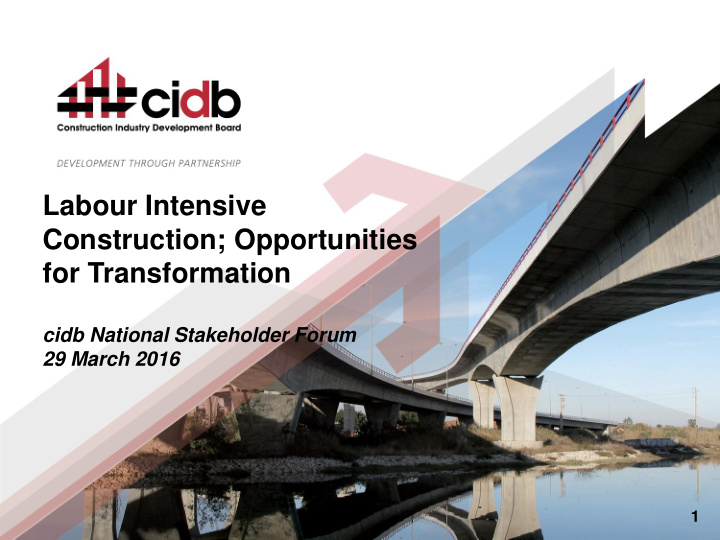



Labour Intensive Construction; Opportunities for Transformation cidb National Stakeholder Forum 29 March 2016 1
References • DPW Guidelines for the Implementation of Labour-Intensive Infrastructure Projects under the Expanded Public Works Programme (EPWP) – SANS 1914-5:2002 Standard for targeted labour participation • Labour-based methods and technologies for employment intensive construction works; A cidb guide to best practice • Implementing employment intensive road works; A cidb practice manual 2
Labour Intensive Construction (LIC) • Labour intensive construction refers to methods of construction: – involving a mix of machines and labour – where labour, utilising hand tools and light plant and equipment, is preferred to the use of heavy machines – where technically and economically feasible • Labour-intensive infrastructure projects under the EPWP include: – using labour intensive construction methods to provide employment opportunities to local unemployed people – providing training or skills development to those locally employed workers – building cost-effective and quality assets 3
Opportunities • General building is inherently labour intensive • Development and maintenance of municipal services, and in particular within townships with limited infrastructure, offer opportunities for labour intensive construction: – low-volume roads (typically less than 500 vehicles per day) – sidewalks and non-motorised transport infrastructure – stormwater drainage – trenching • Need exists to upscale and mainstream EPWP and labour intensive opportunities 4
Contractor Participation • Labour intensive construction: – provides opportunities for participation by small and medium contractors – provides opportunities for growth of contractors – provides opportunities for local labour – often term contracts – low plant requirements – high supervision requirements 5
Role of the Professions • Professions are not adequately skilled in design for labour intensive construction 6
Cost Effectiveness • Constitution: – Section 217 requires that procurement must be cost- effective • EPWP: – Guidelines conform to the PFMA requirement for assessing the cost-effectiveness of capital projects – Normal emphasis on the cost-effectiveness and quality of asset must be retained 7
Wage and Task Rates • EPWP wage rates subject to Ministerial Determination: – R75.10 per day (maximum 8 hours per day) • Bargaining Council for the Civil Engineering Industry: – Task Grade 1 (general worker); R244.17 per 9 hour day – Task Grade 4 (construction hand Gr II); R262.80 per 9 hour day 8
Conclusions • Labour intensive construction is not restricted to EPWP: – EPWP Guidelines and SANS1514-5 can be specified in contract • Labour intensive construction should be used where technically and economically feasible: • need to scale up labour intensive construction • Key decisions impacting on labour intensive construction must be recognised early on in the procurement strategy: – professions need to be trained in labour intensive construction techniques 9
Thank You 10
Recommend
More recommend